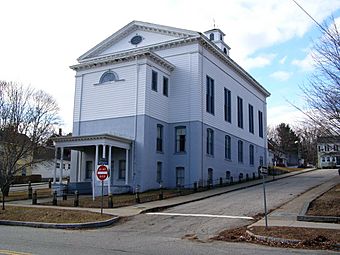Greeneville (Norwich, Connecticut) facts for kids
Quick facts for kids |
|
|
Greeneville Historic District
|
|

Greeneville Congregational Church
|
|
| Location | Roughly along Boswell and Central Aves., Prospect and N. Main Sts., between Hickory and 14th Sts., Norwich, Connecticut |
|---|---|
| Area | 300 acres (120 ha) |
| Architectural style | Greek Revival, Gothic, et al. |
| NRHP reference No. | 05001047 |
| Added to NRHP | September 21, 2005 |
Greeneville is a neighborhood in the city of Norwich, Connecticut. It is located northeast of downtown Norwich. You can find it along the west bank of the Shetucket River.
Most of this neighborhood is part of the Greeneville Historic District. A historic district is a special area with old buildings. These buildings are important because they show how people lived long ago. This district is listed on the National Register of Historic Places. This means it is recognized as a very important historical site in the United States.
Contents
What is the Greeneville Historic District?
The Greeneville Historic District was added to the National Register in 2005. It covers about 300 acres of land. This area includes 683 buildings that help tell the story of the past. It also has seven other important structures and one historical site.
How the District Was Planned
The boundaries of the district were carefully chosen. They include the original village area from 1833. The district also has streets that were built later. These newer streets helped house more people as the area grew. Some parts outside the district were left out. This was because they had fewer old buildings or a different building style.
A Village Built for Industry
Greeneville was a special industrial village. It was created to support factories that used water power. This happened from 1828 until about 1940. The success of this industrial area was largely due to a man named William P. Greene. He lived from 1795 to 1862.
William P. Greene's Vision
William P. Greene had a great idea. He planned this community carefully. He also started a company to provide power to the factories. Later, new technology helped the factories even more. This made Greeneville the biggest industrial area in Norwich.
A Self-Sufficient Community
Even though Greeneville became part of Norwich in 1875, it stayed quite independent. For a long time, it was a community where working-class families lived. They had everything they needed close by. The district has many well-kept homes, public buildings, and shops. These buildings show how the community grew over time.
Architectural Styles in Greeneville
Many buildings in Greeneville have a simple, local style. This is common for a mill town. However, you can also see examples of major architectural styles from that time. These include:
- Greek Revival
- Second Empire
- Italianate
- Carpenter Gothic
These different styles make the district interesting to explore. They show how building designs changed over the years.



